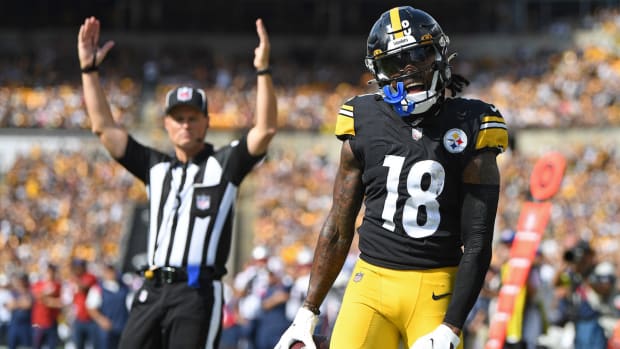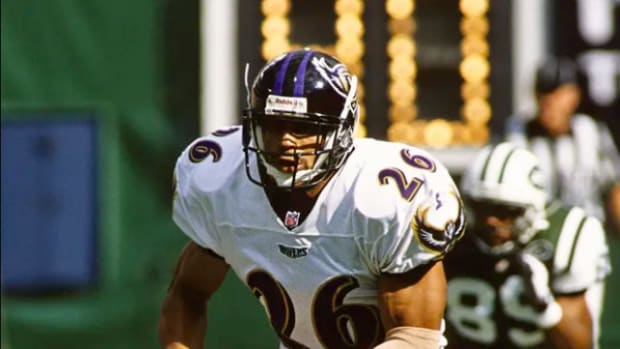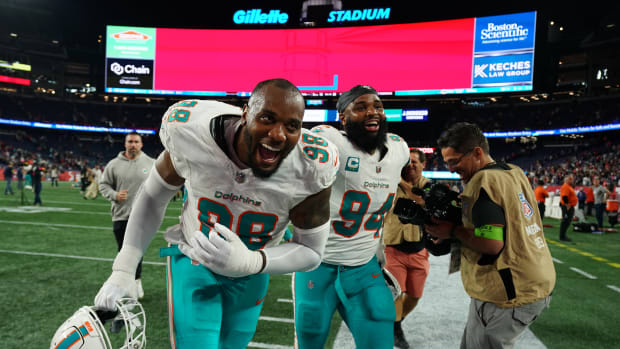Why the Giants and Browns Were Both Willing to Risk the Odell Beckham Jr. Trade
There’s so much to the Odell Beckham trade, it’s hard to know where to start. So I’ll take you back to two things said—one by an owner publicly to the assembled media, and another by a scout to me privately—that explain why Tuesday’s blockbuster went down.
Giants CEO John Mara, October 2018: “I’m not sure it’s going to be a quick fix.”
AFC College Scouting Director, October 2017: “He wasn’t like this [at LSU]. He was a typical receiver—he liked attention and he wanted the ball. He dressed flashy, liked to be at the club, liked having people around him. But when it came to football, he wasn’t like this. This has developed. It’s interesting, he had Jarvis Landry with him and Jarvis was the ultimate Alpha dog.
“Odell was the uber-talented athlete, Jarvis was the dog. And I think having that guy in the receiver room, in the same class as him, it kept him hungry and knowing when to draw that line, because he knew if he didn’t, he might not be the best receiver on his own team.”
It’s all right there.
For the Giants, this risk was about the enormity of the rebuild ahead.
For the Browns, this risk was worth taking because of the fit.
And make no mistake about it, there’s a ton of risk here on both ends. In New York, the risk is in walking away from a transcendent talent with four 1,000-yard seasons and 44 touchdowns under his belt at 26 years old. In Cleveland, the risk is in adding a combustible personality to the mix, just as the Browns seem on their way to fixing cultural issues that have existed in the building off and on (mostly on) for 20 years.
As such, there is a backstory to this one, and we’ll get to that by breaking the trade down from the perspective of each team. But let’s start with how this all came together in the first place.
I’m told the Browns actually started internal discussions on the idea of pursuing Beckham during their free-agent meetings back in December, with GM John Dorsey, ever the aggressor, leading the way on that. Part of the equation for Cleveland was seeing a need to add another offensive playmaker to an already growing skill group, and finding a relatively bare cupboard looming on the UFA market.
At that point, the idea of Beckham was in the abstract, but Dorsey’s department was serious enough about the concept (which they’d whiteboarded and brainstormed on in those meetings) to start doing background work on the Giants star in January. “We had to be very subtle about it,” one source said.
But the Browns still felt like it was pipe dream-ish, given Beckham’s ability and the fact that he’d just signed a new deal in New York. And even when the Kevin Zeitler/Olivier Vernon deal between these same two teams went down last week, a trade involving Beckham didn’t seem likely.
Beckham’s inclusion evolved as an offshoot of that trade—both agreements are going to be processed as one deal with the league Wednesday—and where the teams stood on No. 13 being a part of it is illustrated by his exclusion from the original terms. And it’s a credit to Dorsey that he kept chipping away at it.
The breakthrough, when it started to seem real, happened during a call at 6:30 p.m. ET on Tuesday between Dorsey and Giants GM Dave Gettleman. And by 8 p.m. ET, the news was out there—Beckham was about to be a Brown.
And here, as promised, is some more background on why…
FOR THE BROWNS
We don’t need to waste time on Beckham The Player, and why Cleveland, or anyone, would want that part of it. It’s obvious enough. What’s more interesting is what made the Browns comfortable taking on a guy who’s repeatedly gotten into on-field altercations, rubbed his absence from 2017 offseason work in his coaches’ faces, and torched his team in an interview with ESPN a month after scoring his big extension.
You can start with the quote we led with here. Beckham’s relationship with Landry, who caught 81 balls for 976 yards in his first season with the Browns in 2018, is part of it. Their relationship is almost like that of siblings, in how they compete with and love one another. Another factor is the presence of receivers coach Adam Henry, who was the position coach for those two at LSU in 2012 and ’13. Both those guys gave Dorsey and Co. a great headstart on their background work in January.
Then, there’s the coach and quarterback. The Browns believe in Freddie Kitchens’s ability to manage personalities and navigate difficult situations, based on his own personality and the evidence he gave them as the team surged down the stretch last year. And Baker Mayfield not only has a pre-existing relationship with Beckham, but is the type to set expectations for teammates, bring them a degree of confidence, and push back on them, in a way Eli Manning wasn’t always willing to with Beckham.
It also should be said that, going back to his time as Chiefs GM, Dorsey’s done a lot of work on Beckham, who he had ranked the best in a bumper crop of receivers in the 2014 draft.
FOR THE GIANTS
Those in the Giants’ building trace the issue with Beckham back to his confrontation in Week 15 of 2015 with then-Panthers CB Josh Norman, and Tom Coughlin’s decision not to take him off the field. Coughlin was fired two weeks later, and the tone was set for the next coach, Ben McAdoo, who made the playoffs letting Beckham play by his own rules in 2016, then watched as things came undone under those conditions a year later.
The Giants know he’s an incredible talent, and from that perspective he clearly deserved the five-year, $90 million extension the team gave him in August. But why do that deal if you’re not keeping him long-term?
Really, there were three pieces to it. One, it was to give new coach Pat Shurmur the best chance to get the most out of him. Two, based on the structure and guarantees, it was a very team-friendly deal. And three, as such, the contract actually made Beckham more attractive—signed long-term at a reasonable rate—as a trade chip.
As the year went on, Beckham was actually fine in the building—he’d playfully pop his head in defensive meeting rooms from time-to-time, and was engaged for most of the year. And he remained well-liked by his teammates.
In fact, if there was anything that raised a red flag this year internally, it was his handling of a quad issue at the end of the season. He bruised it against Philly in Week 12, but finished that game, and played the next week against the Bears. But after aggravating in practice in the days following the Chicago game, he essentially shut it down for the year, when some thought he could push through.
That was just a little something, with a player that always seemed to have a little something going on, and that’s part of the deal here.
And while all that was going on, we got the realization from the upper management in New York—as illustrated by what Mara said—that a major rebuild was in order. That’s where the team is now. They’ve got a ton of holes to fill. Really, there are no long-term cornerstones in place on defense, and only a couple (Saquon Barkley, Evan Engram) on offense.
Would Beckham be good for young players (and particularly a young quarterback) coming in? Would he handle the pain of an organizational overhaul well? Or would the Giants be better off getting capital to juice the rebuild, rather than guessing on how Beckham would deal with it and what he’d be when it was complete?
Those are questions that have been asked. And now answered.
You know how this works. A trade happens, and the team that gets the superstar has a parade a thrown for it, and the team getting rid one gets crushed—it’s a story as old as Herschel Walker himself.
As such, we may not know who won this trade for a while.
But we know it’ll be exciting going forward in Cleveland, and interesting from here in New York. And, really, it’s the risk itself in the deal, from both sides, that makes it that way.
• Question or comment? Email us at talkback@themmqb.com.




































